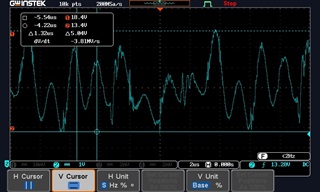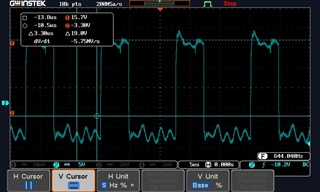I designed two gate drivers using the IC ISO5852S to be used in a half-bridge LLC resonant converter. One Gate drive is responsible for triggering two switches ( Working in parallel to divide the current on the switches) at the upper part of the leg of the half-bridge, and the other one is responsible for triggering two switches ( again, working in parallel to divide the current on the switches) at the lower part of the leg. A push-pull arrangement is being used after both ICs to boost the current that goes to the IGBTs.The switching frequency used is 80 kHz. the power of the half-bridge converter is 6 kW.
My team was testing the power circuit and the IC got permanently damaged in the middle of the process. When I checked its terminals, The VEE and the VCC were shortcircuited.
The signal after the ICs (that goes to the Push-pull) was a bit noisy, but nothing really bad. On the IGBTs, it also looked very decent.
On the other hand, at the input of the IC, the signal at the pin IN+ was very distorted. I tried to filter it with a low pass filter, and I used a Zener diode to limit the maximum and minimum values of the signal, but nothing seemed to work.
I suspect that the distortion might be related to the source of the input signal. To adapt the setup of a preview prototype, which has the gate drive in a separate board, we are using the output signal of this preview gate drive IC (which is an IR2213) as the input of the IC ISO5852S. The main issue with that is regarding the output of the IR2213. It is an IC designed to be used as a half-bridge driver. Due to that, it has two inputs: the low output is referred to as the ground, and the high output is referred to as a floating point. To turn these two outputs into two inputs for our two ISO5852S ICs, we connected the floating point to the ground, but I always had many doubts about that. We never paid attention to that though, because when we saw the input signals of the ICs ISO5852S without providing voltage (300 V) to the Half-bridge bus (we were analyzing the driver signals, before providing power to the half-bridge circuit), everything was ok, but as soon as the Half-bridge starts operating with its DC bus at its nominal voltage, and at full load, the input signal of the IC ISO5852 gets distorted. It is important to point out that the output supply of the IC is completely isolated from the input supply, due to an isolated DC-DC converter.
Given the above, I´d like to ask you, what do you think about these input distortions? Does any perturbation on the input could somehow damage the output of the IC and shortcircuit the VEE and VCC?
What are the main causes of this kind of damage in the IC?
Thank you.




